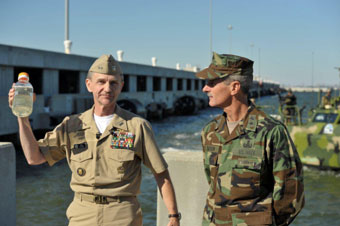The Mission Case for DoD Sustainability
The Department of Defense (DoD), as the largest Federal department and standard-bearer for superior performance, is expected to use its buying power to markedly help the Obama Administration’s efforts to build a green economy. DoD’s sizeable footprint – in terms of people, finances and natural resources consumed and protected – means a sizeable impact. For example, the Department of Army manages more than 100 installations in the United States alone, with a civilian workforce of approximately 300,000. The U.S. Air Force is the principal consumer of energy in the Federal Government, and the U.S. Navy is larger than the navies of several of the largest international militaries combined.
DoD’s ability to respond to current and future contingencies is tied to its ability to develop and to deliver the right capability to the right place at the right time. As such, it has adopted a sustainability vision reflective of these mission responsibilities. To DoD, sustainability means the ability to operate into the future without decline – either in the mission or natural and manufactured systems that support it. The Department’s Strategic Sustainability Performance Plan (SSPP), released August 2010, reflects the thinking that sustainability is a strategic and tactical necessity for successful mission execution.
Sustainability is about using foresight to gain insight. It’s about creating capability to adapt and to overcome challenges and to respond effectively in a fiscally, environmentally and socially responsible manner. The Army captured the idea of this balance when it coined the phrase “Triple Bottom Line Plus” in its Sustainability Planning Guide. Some businesses have adopted sustainability as a means to identify new product lines or to improve public perception of their enterprise. Other businesses have adopted a systems-thinking approach to sustainability by analyzing business processes, such as manufacturing or transportation, to find efficiencies that improve profit margins. The Defense Department has a similar approach but is going further by articulating sustainability as fundamental to its mission success. In short, DoD’s business case for pursuing sustainability is that sustaining mission capabilities in an affordable manner is crucial to defense.
The Business Case: It’s all About the Mission
The DoD challenge is to maintain ability to develop and to deliver capabilities required to address future missions and contingencies in the face of an uncertain strategic environment. It must continue to deter potential nation-state adversaries and to provide a force for stability in a resource-constrained world. In order to thrive, the Department requires a built infrastructure and robust natural resource base to support training, testing and operations. DoD requires a balanced strategy to ensure it has ready capabilities to address challenges to the Nation’s security and well-being. This requires an industrial base and supply chain capable of rapidly and efficiently developing and producing superior weapons and systems to deter future challenges and challengers to national security.

Photo Credit: Army Environmental Command
It also requires educational and research facilities to incubate and to develop organizational paradigms and operational techniques that bring the greatest value required to execute its mission. DoD’s organizations and services must be responsive, effective and efficient to manage and distribute resources to develop and maintain capabilities required to meet the mission.
Pursuing sustainability helps keep the current mission in focus today while also considering mid– and long-term impacts that enable future capabilities. DoD looks at four areas as a means to this end: improving sustainable behavior, improving life-cycle analysis tools to improve decision-making, encouraging adoption of existing or new technologies and processes, and investing in testing and validation of step-change technologies for commercialization.
The Department’s sustainability efforts span all aspects of its mission portfolio including: military operations, installations management and acquisition, procurement and logistics. Sustainability presents valuable opportunities to improve fiscal responsibility by more rigorously evaluating total lifecycle costs to optimize efficient use of resources over long-term. As such, just as sustainability improves corporate fiscal bottom lines, it does so for Federal agencies. Savings can be used to reduce budgets or directed to other priority mission needs.
Mission Readiness: A New Strategy
Napoleon’s army may have run on its stomach, but the modern military runs on kerosene and diesel fuel for electricity. This creates significant supply lines vulnerable to adversaries. By incorporating renewable energy sources into the energy mix – like solar, wind and biomass – operational commanders gain a degree of freedom from vulnerable supply lines. This means fewer troops engaged in obtaining and protecting supplies, which reduces exposure to hostile fire and potential injury on dangerous convoy duty. This helps secure the primary mission. In the United States, metering, efficiency gains and a diverse mix of power sources help DoD manage energy demands and cope with the country’s increasingly fragile power grid. This provides operational flexibility while ensuring that critical functions can be continued (or rapidly regained) in the face of manmade and natural disasters.

U.S. Air Force Graphic/Mike Carabajal
In its SSPP, DoD stressed the mission readiness importance of increasing installation renewable energy generation in order to ensure uninterrupted power supply in the event of electricity grid disruption. The Air Force is already making this vision a reality by implementing plans to add 47 megawatts (MW) of solar energy generation capacity to three of its Southwest installations. At Nevada’s Nellis Air Force Base (AFB), 17 MW of solar photovoltaic capacity will be added during 2012 to the 14 MW array installed in 2007. The Nellis solar array is already the largest in the United States. Two Arizona bases, Davis Monthan AFB and Luke AFB, have developed plans for almost 30 MW of combined solar energy on underutilized base property. At Tucson’s Davis Monthan AFB, a solar electricity company is scheduled to build and to operate a 14.5 MW system on 130 acres of base land, which will provide an anticipated 35 percent of the base’s electricity needs. Luke AFB partnered with an Arizona electric utility to install a 15 MW array expected to supply half the base’s electricity needs while yielding $10 million in savings within 25 years.
The Department of the Navy is in the process of installing advanced meters to track electricity, natural gas, water and steam usage in its 22,000 buildings. Advanced metering measures consumption in real-time to allow optimization of resource efficiency, which reduces costs. The Navy spent approximately one year designing the metering systems to ensure their compatibility with conditions on Navy and Marine Corps installations, as well as mission needs. For example, it was critical that energy data transmission be accomplished without introducing cybersecurity risks.
Mission Capability: Creative Convergence
Sustainability is being incorporated into areas far broader than energy security. For example, in 2010 the Navy opened its first “Sustainable Interiors Showroom,” which features sustainable products for interior office furniture, flooring and lighting, as well as products for exterior pedestrian areas. The Showroom, created to assist efforts to achieve zero net waste by 2035, consists of a demonstration area, resource education center and product library displaying sustainable choices for products commonly required for building interiors. It enables visitors to experience sustainable products in a real working office and conference facility. And, it helps them gather information that streamlines purchasing processes while satisfying multiple vendor-bid and green procurement requirements.
As part of its sustainability efforts, the Department is pursuing sustainable manufacturing at its manufacturing facilities (arsenals, depots and shipyards) and through its components and systems procurement. Moreover, the Air Force’s Manufacturing Technology Program has initiated a Sustainable Aerospace Manufacturing Initiative to mature sustainable manufacturing practices. This program will enhance production capability necessary to process and to fabricate DoD weapons systems with optimized energy footprints and environmentally sustainable processes while preserving performance requirements. Such efforts demonstrate that sustainability initiatives rooted in mission goals can have far-reaching benefits, such as improving competitiveness of U.S. manufacturers.
Successful implementation of DoD’s sustainability plan will be driven in large part by acceptance and support of the sustainability ethic by guardians of the organization’s culture. The military’s unique and deeply rooted culture exhibits a strong operational ethic that can be leveraged to instill sustainability into everyday decisions and actions across mission areas. Given a clear mission objective, the Defense Department will embrace it and obtain it. Its Strategic Sustainability Performance Plan was written to demonstrate mission benefits and to provide clear, measurable objectives.
Rear Adm. Philip Cullom, director of the Energy and Environmental Readiness Division, left, and Rear Adm. Michael P. Tillotson, commander of Navy Expeditionary Combat Command, show the alternative fuel blend of 50% algae-based and 50% NATO F-76 fuels during a press conference at Naval Station Norfolk. |
 U.S. Navy photo by Mass Communication Specialist 2nd Class Gregory N. Juday/Released |
DoD is especially adept at encouraging and rewarding good decisions that engage innovative approaches yielding creative solutions to demanding issues. But quality decisions don’t just happen; they require getting the right information into the right decision process at the right time. Sustainability also requires complex systems-thinking that considers a sometimes longer analytical time frame. Collecting, structuring and analyzing information to help decision-makers understand the business case for investing in sustainable approaches requires good data and good decision tools. These tools must help decision-makers broaden their aperture to consider direct and indirect costs, some of which will be incurred by others in the future. Careful consideration of total ownership costs must become normal business practices. As important as good data and decision tools will be to successfully pursuing sustainability, the DoD strategy is also based on investing and empowering people – enabling creativity and incentivizing sustainable decisions.
Mission Certainty: Change
DoD will continue to face a dynamic global environment and its mission of providing security and stability within that environment will continue to be challenging. Sustaining, innovating and maturing capabilities required for successful, future operation will be critical for the Department and the Nation. Sustainability requires foresight and systems-thinking. It creates insights regarding driving forces for current and future trends as well as impact areas. Such insights can enhance military readiness while lowering total operating costs. As sustainability is further embraced by DoD as part of its ethic, it will become more broadly integrated into the decision structure, and into values and calculations that will help drive innovation and creativity needed to develop solutions to novel problems of the future.





























